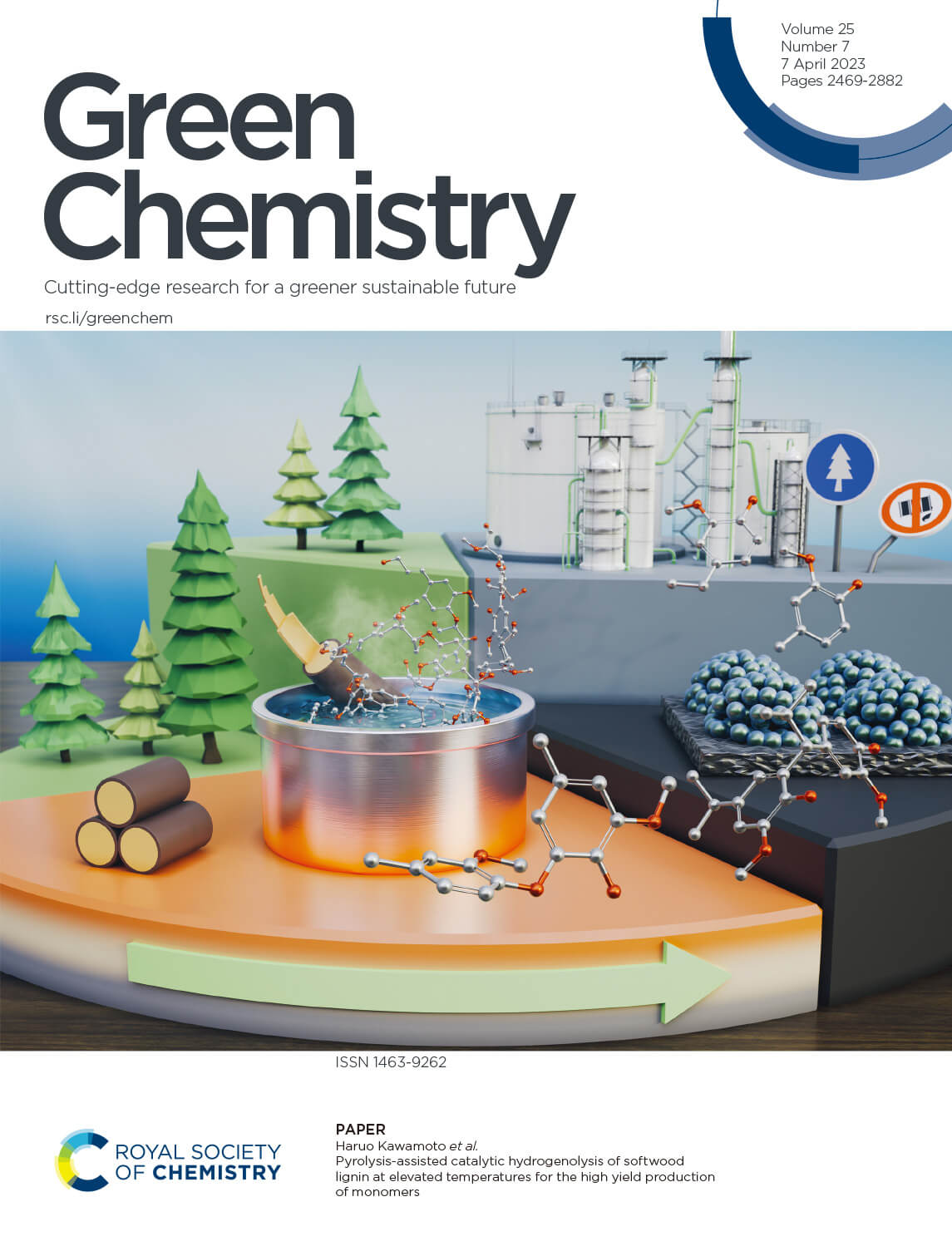論文雑誌「Green Chemistry」のカバーピクチャーを制作しました[京都大学]
弊社で制作しました京都大学 河本晴雄先生よりご依頼のカバーアートが、
イギリスの王立化学会発行の学術雑誌 Green Chemistry
2023年4月号 Front Coverに採用されました。

Client
京都大学
エネルギー科学研究科
河本晴雄先生
エネルギー科学研究科
河本晴雄先生
Journal
Green Chemistry
07 April 2023, Issue 7 Link
07 April 2023, Issue 7 Link
Pyrolysis-assisted catalytic hydrogenolysis of softwood lignin at elevated temperatures for the high yield production of monomers
Jiaqi Wang, Eiji Minami and Haruo Kawamoto
The catalytic hydrogenolysis of softwood lignins is normally conducted at temperatures below 200 °C but tends to provide monomer yields of less than 30 mol% as a consequence of the non-cleavable 4-O-5 and condensed (C–C) linkages of phenylpropane units in lignin. In the present study, catalytic hydrogenolysis at higher temperatures (250–350 °C) with the addition of Pd/C and H2 in anisole provided very high monomer yields of 62 and 43.5 mol% (based on the quantity of aromatic rings in the original lignin) from milled wood lignin and organosolv lignin, respectively. Both these materials were isolated from Japanese cedar wood (a softwood). An analysis of the dimeric products and catalytic hydrogenolysis trials using model dimers established that the cleavage of 4-O-5 and condensed bonds was responsible for these high monomer yields. Specifically, Cα–aryl-type condensed bonds formed by condensation reactions during pyrolysis and the organosolv process were efficiently cleaved. This cleavage favored the production of monomers because condensation forming Cα–aryl bonds normally inhibit monomer formation to a significant extent. The undesirable saturation of aromatic rings was also suppressed at such high temperatures. The Pd/C catalyst but not the addition of H2 was determined to be necessary for high monomer yields and the pyrolytic degradation of the lignin evidently played an important role in this transformation. On the basis of these data, the high temperature process reported herein is termed pyrolysis-assisted catalytic hydrogenolysis.
Link
Jiaqi Wang, Eiji Minami and Haruo Kawamoto
The catalytic hydrogenolysis of softwood lignins is normally conducted at temperatures below 200 °C but tends to provide monomer yields of less than 30 mol% as a consequence of the non-cleavable 4-O-5 and condensed (C–C) linkages of phenylpropane units in lignin. In the present study, catalytic hydrogenolysis at higher temperatures (250–350 °C) with the addition of Pd/C and H2 in anisole provided very high monomer yields of 62 and 43.5 mol% (based on the quantity of aromatic rings in the original lignin) from milled wood lignin and organosolv lignin, respectively. Both these materials were isolated from Japanese cedar wood (a softwood). An analysis of the dimeric products and catalytic hydrogenolysis trials using model dimers established that the cleavage of 4-O-5 and condensed bonds was responsible for these high monomer yields. Specifically, Cα–aryl-type condensed bonds formed by condensation reactions during pyrolysis and the organosolv process were efficiently cleaved. This cleavage favored the production of monomers because condensation forming Cα–aryl bonds normally inhibit monomer formation to a significant extent. The undesirable saturation of aromatic rings was also suppressed at such high temperatures. The Pd/C catalyst but not the addition of H2 was determined to be necessary for high monomer yields and the pyrolytic degradation of the lignin evidently played an important role in this transformation. On the basis of these data, the high temperature process reported herein is termed pyrolysis-assisted catalytic hydrogenolysis.
Link
